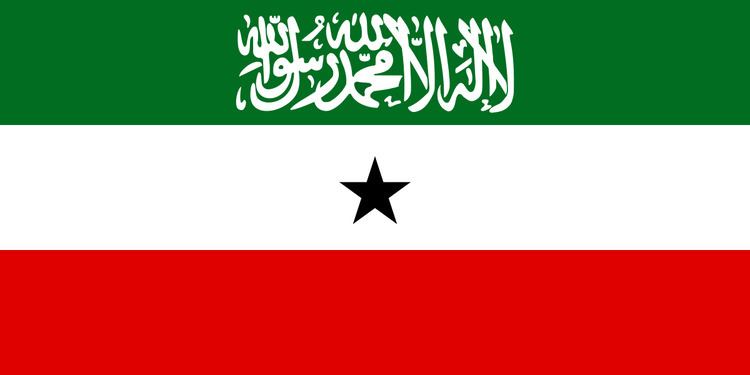Adopted October 14, 1993 | Proportion 1:2 | |
 | ||
The flag of Somaliland is used in Somaliland, a self-declared republic that is internationally recognized as an autonomous region of Somalia. Having established its own local government in 1991, the region's self-declared independence remains unrecognized by any country or international organization. It contains the Pan-Arab colors of green, black, white and red. On the green stripe, there is the Sunni Shahada in white script, similar to that of the Saudi Arabian flag.
Contents
The Constitution of Somaliland, as approved on May 31, 2001, by referendum:
Article 7: The Flag, the Emblem and the National Anthem
1. The flag of the Republic of Somaliland shall consist of three horizontal, parallel and equal sections, the top section, which is coloured green and has inscribed in its midst in white in Arabic language La Ilaha Ill-Allah, Muhammadan Rasulullah ( لا إله إلاَّ الله محمد رسول الله, There is no god except for God, and Muhammad is the messenger of God); the middle section is white and has at its centre a black star; and the bottom section is coloured red.
Rules for the usage of the flag
The government set out principles on how to use the flag. It should be treated with respect and used very carefully and sensitivity. Because the Shahada has huge importance in Islam, the first pillar of Islam etc, regulations have specially been made on the usage of the flag.
Half mast
It is forbidden for Somalis to fly the flag at half mast because it has the Shahada (which says in Arabic There is no other god except God, Muhammad is the Messenger of God) written on it so it will be an un-Islamic and disrespectful way to treat the flag. Even if the President or someone with a high Somaliland governmental status dies, the flag does not fly at half-mast. When the second President of Somaliland Muhammad Haji Ibrahim Egal died, he received a state funeral and thousands of Somalis flocked to witness his funeral and mourn his death but the flag of Somaliland was raised at full mast instead of the traditional half-mast gesture. Moreover, if a person is seen lowering the flag at half-mast, they might be taken to jail or to court and it would be considered as a criminal offense. Similar rules, for the same reason, also apply to the flags of Afghanistan, Saudi Arabia and Iraq.
Alternative flags
Although the aforementioned Article 7 clearly states that the bottom of the flag is red, many versions have been seen with a clear orange color instead. Another variation is the orientation of the star, many Somaliland flags have the star pointing the opposite direction from other flags, this upside-down star version is used quite widely.
Some flags have a plain green band, without the Shahada, hence may be exempt from the half-mast rule (although this is unclear); other flags have the Shahada written along the full length of the green stripe.
Most Somaliland flags are of the ratio 2:1. It is based on the official ratio of the Union Flag of the United Kingdom, the former colonial power. Pictures of flags on the internet etc. often erroneously show a shorter flag (of ratio 2:3 etc.).
1903 – 1950
When the British annexed and occupied northwestern present-day Somalia in 1903, they established a protectorate and made it part of the British Empire. The British adopted a new flag for the region (officially named British Somaliland). Like many Commonwealth countries, the flag had a defaced Blue Ensign: a blue field with the Union Flag in the upper hoist quarter of the flag. There was an image of a Kudu (an antelope native to the British Somaliland area) on a white disc. The flag was flown on ships owned by residents of British Somaliland or on government buildings in the territory.
1950 – 1960
In 1950 The Protectorate of British Somaliland's badge and flag changed and thus all flags which bore it. The flag still had the Union flag on the quarter-hoist. The Kudu's head and shoulders were retained and taken off to form the most dominant feature on the new arms, although the antelope's face was now looking straight out at the observer. Between its horns, the Royal crown was inserted to symbolize the Royal family and the British Empire in general.
The badge was changed as well; it consisted of an escutcheon divided vertically into green and blue colours, having a chief with a golden Somali shield in front of two spears in saltire, heads downwards, in natural colours. The green portion contained an image of a white minaret. Moreover, on the blue quarter, an Arabian dhow in full sail on waves of the sea, with a golden anchor in the base. The Kudu's head was facing forward to the observer instead of facing left on the earlier version. Above, the Kudu was the Royal Crown between the horns. Underneath, there was a wreath coloured in green and yellow which formed the Crest.
When British Somaliland was granted independence on 26 June 1960 and united as planned with Italian Somaliland on 1 July 1960, the flag ceased being used.
